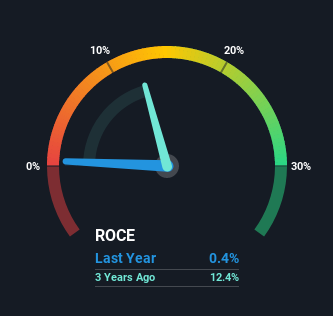- Malaysia
- /
- Construction
- /
- KLSE:ROHAS
Capital Allocation Trends At Rohas Tecnic Berhad (KLSE:ROHAS) Aren't Ideal

Did you know there are some financial metrics that can provide clues of a potential multi-bagger? Firstly, we'd want to identify a growing return on capital employed (ROCE) and then alongside that, an ever-increasing base of capital employed. Ultimately, this demonstrates that it's a business that is reinvesting profits at increasing rates of return. However, after briefly looking over the numbers, we don't think Rohas Tecnic Berhad (KLSE:ROHAS) has the makings of a multi-bagger going forward, but let's have a look at why that may be.
Understanding Return On Capital Employed (ROCE)
For those who don't know, ROCE is a measure of a company's yearly pre-tax profit (its return), relative to the capital employed in the business. Analysts use this formula to calculate it for Rohas Tecnic Berhad:
Return on Capital Employed = Earnings Before Interest and Tax (EBIT) ÷ (Total Assets - Current Liabilities)
0.0043 = RM1.6m ÷ (RM578m - RM201m) (Based on the trailing twelve months to December 2020).
Therefore, Rohas Tecnic Berhad has an ROCE of 0.4%. In absolute terms, that's a low return and it also under-performs the Construction industry average of 4.8%.
View our latest analysis for Rohas Tecnic Berhad

In the above chart we have measured Rohas Tecnic Berhad's prior ROCE against its prior performance, but the future is arguably more important. If you'd like to see what analysts are forecasting going forward, you should check out our free report for Rohas Tecnic Berhad.
What Can We Tell From Rohas Tecnic Berhad's ROCE Trend?
In terms of Rohas Tecnic Berhad's historical ROCE movements, the trend isn't fantastic. To be more specific, ROCE has fallen from 18% over the last four years. And considering revenue has dropped while employing more capital, we'd be cautious. This could mean that the business is losing its competitive advantage or market share, because while more money is being put into ventures, it's actually producing a lower return - "less bang for their buck" per se.
The Key Takeaway
We're a bit apprehensive about Rohas Tecnic Berhad because despite more capital being deployed in the business, returns on that capital and sales have both fallen. We expect this has contributed to the stock plummeting 72% during the last three years. With underlying trends that aren't great in these areas, we'd consider looking elsewhere.
On a separate note, we've found 1 warning sign for Rohas Tecnic Berhad you'll probably want to know about.
If you want to search for solid companies with great earnings, check out this free list of companies with good balance sheets and impressive returns on equity.
When trading stocks or any other investment, use the platform considered by many to be the Professional's Gateway to the Worlds Market, Interactive Brokers. You get the lowest-cost* trading on stocks, options, futures, forex, bonds and funds worldwide from a single integrated account. Promoted
If you're looking to trade Rohas Tecnic Berhad, open an account with the lowest-cost platform trusted by professionals, Interactive Brokers.
With clients in over 200 countries and territories, and access to 160 markets, IBKR lets you trade stocks, options, futures, forex, bonds and funds from a single integrated account.
Enjoy no hidden fees, no account minimums, and FX conversion rates as low as 0.03%, far better than what most brokers offer.
Sponsored ContentNew: AI Stock Screener & Alerts
Our new AI Stock Screener scans the market every day to uncover opportunities.
• Dividend Powerhouses (3%+ Yield)
• Undervalued Small Caps with Insider Buying
• High growth Tech and AI Companies
Or build your own from over 50 metrics.
This article by Simply Wall St is general in nature. It does not constitute a recommendation to buy or sell any stock, and does not take account of your objectives, or your financial situation. We aim to bring you long-term focused analysis driven by fundamental data. Note that our analysis may not factor in the latest price-sensitive company announcements or qualitative material. Simply Wall St has no position in any stocks mentioned.
*Interactive Brokers Rated Lowest Cost Broker by StockBrokers.com Annual Online Review 2020
Have feedback on this article? Concerned about the content? Get in touch with us directly. Alternatively, email editorial-team (at) simplywallst.com.
About KLSE:ROHAS
Rohas Tecnic Berhad
An investment holding company, manufactures steel lattice towers and monopoles for power transmission and telecommunications in Malaysia, Bangladesh, Cambodia, and Nepal.
Mediocre balance sheet and slightly overvalued.
Market Insights
Community Narratives



